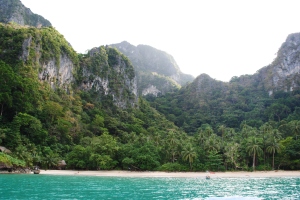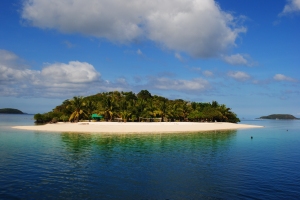Remote, lush, sparsely populated – northern Palawan is often called the Philippine’s ‘last frontier’, a region of stunning natural beauty, rustic charm, and nearly unmatched diving and snorkeling environments. Home to the Calamian Islands, the Palawan archipelago is composed of sparsely populated or altogether uninhabited bits of jungle covered rock accessible primarily through local tour companies or private boats.
For travelers hoping to escape the crowds and commercialization of more conventional destinations like Phuket or Bali, you can’t do much better than this oft-underappreciated corner of Southeast Asia. While a variety of vendors, routes, and itineraries are available, we settled on Tao Philippines, a small company specializing in 5 day expeditions between Coron and El Nido, two small seaside towns in northern Palawan.

A pile of Matambaka (also known as Big Eyed Scad) await buyers from a counter top in Coron’s fish market. As international fishing fleets have moved into the waters surrounding Palawan local catches have dropped off to unprecedentedly low levels, endangering fisheries and the single most important economic and dietary resource for locals.
So, at 8:30 am the first day, we strolled through Coron’s public market, past the stalls of ubiquitous, imported, plastic Chinese doodads, past the fish mongers and the boatmen, out to the wharf and were ferried out to the Buhay, a long, narrow, two-story boat that would become our floating home (during the day at least) for almost a week.
This particular expedition worked roughly as such: each day was spent cliff jumping, fishing, snorkeling reefs and shipwrecks, kayaking, swimming, or just enjoying empty beaches – or a combination thereof, and each night the boat stopped at a camp, which are scattered liberally between Coron and El Nido, to rest, relax, and fill ourselves with intoxicating amounts of food and booze. Accommodations are similar, almost identical actually (bamboo and thatch huts), but the personality and surroundings of each camp vary widely.
Our first stop, Pass Island, was a semi-circular speck of land raised barely twenty meters above the sea at its highest. I doffed my shoes and raced local children up a small berm, to the low bluffs on the leeward shore to capture the sunset with my lowly point and shoot, managing to avoid any serious injuries from the dried coral scattered across the groud. That night we feasted. Fresh mackerel, vegetable curry, rice, San Miguel Pilsens – packing all that food and drink onto a full day of snorkeling and a stage 3 sunburn made it an easy call to dive under the mosquito nets at a decent hour. But not before checking out the nighttime sky. There are stars at night in Palawan, and by stars I don’t mean a light dusting of the brightest neighboring suns. I mean the disc of the Milky Way can be seen edge on, a river of glittering cosmic sand flowing right down the middle of the sky.
I woke up on the second day and knew, instantly, I couldn’t go shirtless for the rest of the trip. My back looked like a Rorschach test. A small constellation of pasty splotches set against an angry, blood red backdrop of sunburned flesh. I doused myself in SPF 80 and sat down for the morning meal: Puso ng Saging – banana blossom fritters, buttered bread, fried eggs, and fruit. Traditional Philippino meals and snacks are delicious, communal events. Most of the ingredients were gathered or caught the day of preparation. Fresh fish, coconut, bananas, papaya, sweet potatoes, turmeric, ginger, eggs, pork, chicken – travelers literally watch their food go from farm, forest, and sea to fork.

Sailing toward the boundary waters of the Sulu and South China Seas. Arao beach sits to the left, with the ‘7-11’ just visible amongst the palms ahead. A thin shallow band of emerald water hugs to shoreline, indicating the tidal zone, and rapidly plunges off into thriving coral deeps.
After breakfeast it was off the island, onto the Buhay, and wending south to Arao beach, codenamed ‘7-11’ by locals for its small ‘convenience store’ – a diminutive hut selling fish and basic supplies. Arao is an absolutely stunning ribbon of white sand set beside a narrow strait at the confluence two currents, one from the South China Sea, the other from the Sulu Sea. Nutrient rich waters have produced a gorgeous reef, extending perhaps 50 meters from shore and running in an explosive, multi-colored riot of sea creatures and corals off into the deeps of the strait.
Our second day ended at Kulaylayan, a secluded cove on Linapacan Island, under a liquid sunset. We all sang videoke (from where this machine came I have no idea) on bellies fully of Tanguay rum and white snapper, tried to climb coconut trees, and caroused around a bonfire until dawn. I carried my thin mattress and sheet out to the beach and slept for a few hours under a low tree. A brief note about rum and Filipino homeopathy: if suffering from a cold or sinus problems, pour out a handful of Tanguay, a caramel colored elixir of near medical strength, and snort it. My third night was spent under the towering canopy of a coconut grove where an entire hog was roasting as the boat pulled ashore. Amid steaming plates of pork, sweet potatoes, and green beans everyone shared stories until at least 3 am.

Preparing to drop anchor off Cadlao with its ancient jungles and Kharst walled guardian mesas. Tao village, located just beyond the beach at its left end, is the seasonal home of Tao Philippine’s owners – an undeniably wise choice considering the staggering amounts of natural beauty permeating every square inch of the island.
Cadlao, an island lying just west of El Nido, was home to the fourth and final camp. Approaching Cadlao is like sailing out of the twenty first century into a primordial, forgotten land; thrumming jungle lies just beyond the beach that is, in turn, backed by towering limestone cliffs reaching vertically almost 300 meters. An ecological preserve, the island is covered in old-growth, multi-canopied topical forest with enormous trees and cacophonous wildlife. Swiftlets, whose nests are collected and exported to China filled the air above camp, travelers passed around beer and food, and I, nearing the end of the trip laid in a hammock and listened to the jungle and the ocean, eating coconut and wondering how the five hour van ride from El Nido to the Puerto Princesa airport over gravel roads was going to be.
It would be easy to run wild with cliché describing this corner of the Philippines. Electric blue water, untouched beaches, vibrant coral and shimmering clouds of fish, a thousand languid pleasures waiting a few short plane rides from the Asian mainland – and every one of them would be an unexaggerated truth. For those who want to get away, really and truly away from loud, high density, chattering tourist districts, Palawan should be somewhere near the top of your shortlist. Just make sure to bring sunscreen.
And, because in-text photos are limited by space, here’s a slideshow if you’d to like to peruse a few more images.
